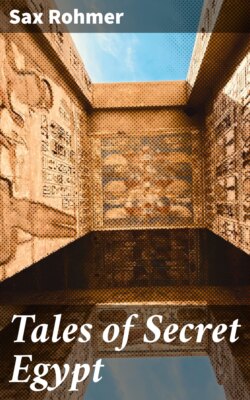Читать книгу Tales of Secret Egypt - Sax Rohmer - Страница 16
На сайте Литреса книга снята с продажи.
V
ОглавлениеTable of Contents
“The truth is now wholly made manifest,” said Abû Tabâh; “the revelation is complete.”
Once more I was mounted upon the white camel and the mysterious imám rode beside me upon its fellow, which was of less remarkable color.
“I hear your words,” I replied.
“The poor Ahmed Abdulla,” he continued, “who was of little wisdom, knew, as Hassan es-Sugra knew, of the hidden ring; for he was one of those who fled from the pyramid refusing to enter it again. Greed spoke to him, however, and he revealed the secret to a certain Englishman, called Bishop, contracting to aid him in recovering the ring.”
At last enlightenment was mine … and it brought in its train a dreadful premonition.
“Something I knew of the peril,” said Abû Tabâh, “but not, at first, all. The Englishman I warned, but he neglected my warning. Already Ahmed Abdulla was dead, having been despatched by his employer to the pyramid; and the people of Rikka had sent for me. Now, by means known to you, I learned that evil powers threatened your life also, in what form I knew not at that time save that the sign of Set had been revealed to me in conjunction with your death.”
I shuddered.
“That the secret of the pyramid was a Pharaoh’s ring I did not learn until later; but now it is made manifest that the thing of power is the death-ring of Sneferu. …”
The huge bulk of the Pyramid of Méydûm loomed above us as he spoke the words, for we were nearly come to our destination; and its proximity occasioned within me a physical chill. I do not think an open check for a thousand pounds would have tempted me to enter the place again. The death-ring of Sneferu possessed uncomfortable and supernatural properties. So far as I was aware, no example of such a ring (the lettre de cachet of the period) was included in any known collection. One dating much after Sneferu, and bearing the cartouche of Apepi II (one of the Hyksos, or Shepherd Kings) came to light late in the nineteenth century; it was reported to be the ring which, traditionally, Joseph wore as emblematical of the power vested in him by Pharaoh. Sir Gaston Maspero and other authorities considered it to be a forgery and it vanished from the ken of connoisseurs. I never learned by what firm it was manufactured.
A mile to the west of the pyramid we found Theo Bishop’s encampment. I thought it to be deserted—until I entered the little tent. …
An oil-lamp stood upon a wooden box; and its rays made yellow the face of the man stretched upon the camp-bed. My premonition was realized; Bishop must have entered the pyramid less than an hour ahead of me; he it was who had stood upon the mound, silhouetted against the sky, when I had first approached the slope. He had met with the fate of Ahmed Abdulla.
He had been dead for at least two hours, and by the token of certain hideous glandular swellings, I knew that he had met his end by the bite of an Egyptian viper.
“Abû Tabâh!” I cried, my voice hoarsely unnatural—“the recess in the King’s Chamber is a viper’s nest!”
“You speak wisdom, Kernaby Pasha; the viper is the servant of the ginn.”
Upon the third finger of his swollen right hand Bishop wore the ring of ghastly history; and the mysterious significance of the Sign of Set became apparent. For added to the usual cartouche of the Pharaoh was the symbol of the god of destruction, thus:
We buried him deeply, piling stones upon the grave, that the jackals of the desert might never disturb the last holder of the death-ring of Sneferu.
